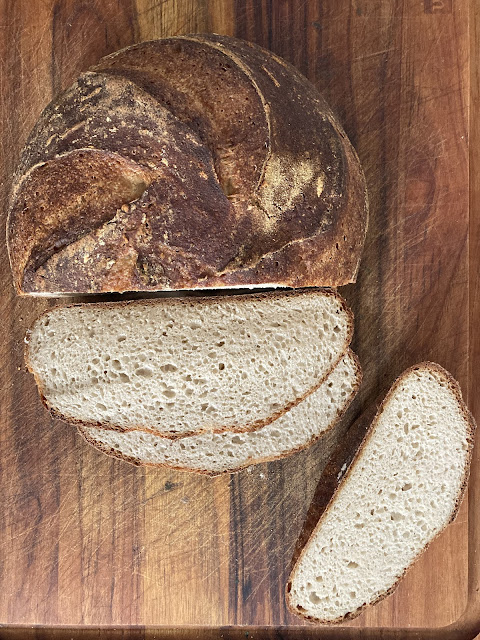Gluten-free Sourdough Discard Bread
You’ve made your gluten free sourdough starter. What now?
The discard, or unused portion of the starter can be repurposed in a number of ways. It’s the part of the starter that you don’t need to refresh or to use to leaven bread. You can throw it out, or you can use it to replace some of the flour and water in other recipes. It adds a great texture and flavor to recipes, and it’s particularly useful for gluten free recipes. There’s something about gf grains that benefits immensely from the fermentation process. They become more flexible, more workable, and much tastier.
In this bread recipe the sourdough starter lends the bread strength, flexibility, and flavor.
Want a sandwich loaf recipe? Check out my Yeasted Sourdough Sandwich Bread.
Why is it not a regular sourdough bread?
This bread is considered a discard bread, or sometimes called a hybrid loaf, because it contains sourdough but it's leavened with commercial yeast.
What does it taste like?
Depending on the ingredients used, this bread can taste anywhere from very mild or even bland to very yeasty and flavorful. It's not usually very sour at all, but it does have a sourdough flavor. The milk enhances the yeasty flavors and helps with the crust browning. The whole psyllium option is healthier and gives a taller, more cohesive loaf but it's a little less flavorful. Ground or powdered psyllium gives a lighter crumb and brings a more intense sourdough flavor to the bread.
Sourdough Discard Boule Bread Recipe
Mix time: 20 min
First rise: 1-1.5 hours
Second rise: 20-60 minutes
Bake time: 45-50 minutes
Note: edited 1/14/24 for amount of whole psyllium due to feedback that the recipe was coming out too wet for some people.
Whisk together in a large bowl or in the bowl of a stand mixer:
275g gluten-free flour blend consisting of:
- 115g potato starch
- 80g sorghum flour
- 40g tapioca starch
- 40g millet flour
Then whisk in:
20g ground/powdered psyllium husk OR 30g whole psyllium husk
8.7g sea salt
3g (or 1 tsp) active dry yeast
Once the dry ingredients are whisked together thoroughly, add:
200g sourdough discard (shown is ivory teff sourdough)
380-440g warm milk or water (45°c/115°f)*
Mix the wet ingredients into the dry ingredients until thoroughly blended.
Let the dough rise until it's 25-50% bigger, about 1-1.5 hours at room temp.
After rising, mix the dough again. Add:
12 g (or 1 TBSP) apple cider vinegar
75g tapioca starch
12g (or 1 TBSP) sugar
When the dough is mixed and smooth, turn it out of the bowl and knead it a few times until it forms a cohesive ball. Shape it into a boule and put it seam side up in a flour banneton or a bowl lined with a well-floured towel. Let rise until it's 25-50% bigger, anywhere from 20 minute to 1 hour depending on the temperature and climate.
Preheat a dutch oven or a cloche in the oven to 230°c/450°f. Once risen, bake the bread covered in the baking vessel for 30 minutes, then uncovered for 20 minutes. If it's getting very brown lower the temperature to 350° and bake until it sounds very hollow when tapped on the bottom with your knuckles, another 5-10 minutes.
Let the bread cool on a rack before slicing.
* Edit 1/21/24 and 3/3/24 amount of liquid needed varies depending on your starter, its hydration, and also your local climate. Use the minimum amount of hydration if any of the following apply:
- you have a rice starter
- your starter is very runny/liquid
- your local climate is 50% humidity or more
Use the maximum hydration if:
- your starter is all teff at 120 hydration or lower
- your local climate is 30% humidity or lower
If you can’t decide, or there are conflicting variables, use the minimum amount of liquid to start out. On the second mix, if it seems dry, add liquid 10 g at a time until the dough seems workable but still firm.
Enjoy your gluten-free bread!






Comments
Thanks
Jennifer
The extra flour and sugar are added after the first rise so that the yeast doesn’t run out of food for the second rise. Gf dough tends to proof very quickly and has a hard time rising a second time without a bit more food for the yeast. As for the vinegar, it’s a natural dough enhancer. It improves the rise, but its effects wear off quickly so I chose to put it in for the second rise. I hope that answers your questions!
Best,
S
Thanks!
Thanks for pointing that out. Tapioca flour and tapioca starch can be used interchangeably. I didn’t realize I’d used two different terms! I’ve edited for clarity.
Thank you so much for your wonderful bread recipe, I made it yesterday and it came out amazing. It rose so quickly on the second rise and I don’t think my oven was hot enough even though it had already biped. I baked it at 450 for 30 min covered, it has risen more but it was very pale, I uncovered it and baked it 20 min. I checked it and it needed more color, I baked it 20 more minutes and it never got browner like yours. I took it out and it’s amazing but still a little tacky, not gummy. I have checked my oven temperature with a thermometer and it was ok. Has this happened to others? Should I bake it the full 50 minutes uncovered without opening the oven next time? I did use millet but I am not supposed to, what would you recommend to substitute? I will appreciate any advise. Thank you so much. Blessings!!
A quick question… my bread has come out tracky should I bake it longer being covered or bake longer being uncovered? Other than that it has turned out perfect just this one will be used for toast 😊
Thank you Claire